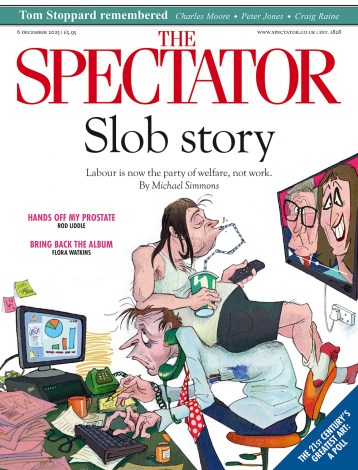Last week, the Office for National Statistics published data showing that income inequality in the UK has fallen to its lowest level since 1996. I’m sure you don’t need me to tell you that – you’ll have doubtless noticed the improvements in social capital, trust and general wellbeing yourself.
How, exactly, does income inequality cause anything?
Because that is how things work according to The Spirit Level, the 2009 bestseller which claimed that almost everything is connected to inequality. Through a series of scatterplots, the social scientists Richard Wilkinson and Kate Pickett sought to prove that ‘more equal’ countries do better on everything from life expectancy to recycling while the benighted ‘less equal’ countries endure higher rates of murder, teen births, drug use and infant mortality.
What the book really showed was the power of confirmation bias. The science, such as it was, suffered from so many flaws that I wrote a whole book about it. The idea that small deviations in a single economic variable could dictate the prevalence of a vast range of health and social problems was always preposterous, but many people on the political left who ought to have known better suspended their disbelief and briefly declared the book to be a masterpiece.
You don’t hear much about The Spirit Level these days. I used to talk about it in schools and universities but I gave up years ago because today’s students have almost never heard of it, yet alone read it. I’d like to think that’s because it’s been thoroughly debunked. When I revisited the data in 2019, there was even less of a correlation between income inequality and social problems than there had been ten years earlier.
And so it was with a sense of awestruck nostalgia that I gazed upon the headline ‘Study links greater inequality to structural changes in children’s brains’ on the Guardian website on Tuesday. The study, published in Nature Mental Health, was co-authored by Kate Pickett and claims to find that the brains of children in ‘less equal’ societies have smaller and thinner cortexes than those in ‘more equal societies’.
The societies in question are US states – but not all 50 of them, just 17. The authors admit that the associations with inequality are ‘small’, but nevertheless leap from correlation to causation and declare that ‘these findings indicate that income inequality may shape brain development in a diffuse and pervasive manner, potentially influencing a wide range of cognitive, emotional and behavioral outcomes in children and adolescents.’
One of the problems with The Spirit Level, aside from the evidence presented, was the causal mechanism. How, exactly, does income inequality cause anything? One can just about imagine rates of property crime and even murder being higher in highly unequal countries, but how could rates of recycling or infant mortality be affected by it? In the few instances in which the correlations were genuine, it was more sensible to assume reverse causation or look for a third variable. With regards to recycling and foreign aid, for example, it seems more likely that governments that prioritise wealth redistribution are also likely to force people to recycle and have a bigger budget for international development. Wilkinson and Pickett rejected such common-sense explanations in favour of some waffle about ‘status anxiety’, and ‘psychosocial pathways’.
Assuming everybody to be as sensitive to inequality as they are, the authors of the new study write: ‘Given the evidence that inequality lower levels of social cohesion, trust and social capital, as well as higher levels of social comparison… it is unsurprising that inequality is associated with higher stress levels.’ That evidence is rather shaky if the truth be known, but they take it even further when they ‘speculate’ that ‘increased stress levels probably contribute to the profound impacts on the brain outcomes in children.’ That is one hell of a reach, especially since the children in the study were aged nine to ten. At that age, their idea of ‘social comparison’ is comparing their Christmas presents with those of their friends. They may be aware that there are people in their state who are much richer (or poorer) than them, but why stop at the state level? It is equally true at the national or international level.
Nevertheless, the authors declare that ‘structural inequality should be considered a harmful social determinant… meriting attention in efforts to improve population mental health, regardless of political ideology.’ The cure, they say, involves ‘economic reform including progressive taxation, increased social safety nets and universal healthcare’, plus ‘investments in public infrastructure’.
If that seems an excessively strong conclusion to draw from such thin findings, the authors are keen to point out that they are not alone in identifying income inequality as a cause of biological phenomena. They cite a study which apparently showed that ‘C-reactive protein levels, a marker of inflammation, were lowest in more equal societies (for example, Switzerland) and highest in more unequal ones (for example, Portugal)’. Switzerland is not, in fact, a ‘more equal’ society. It wasn’t ‘more equal’ when The Spirit Level was written and it isn’t ‘more equal’ today (it is below the UK, Serbia and Jordan in the latest World Bank figures). It was the most equal society in the study they mention, but that study only looked at four countries. Of the four, Switzerland was the richest and Portugal was the poorest (the others were Ireland and the UK). I don’t know what C-reactive protein levels are or what they have to do with the price of fish, but I do know that there is generally a pretty good connection between wealth and health. Perhaps a little more wealth would be good for our health?
The Spirit Level was published after the financial crisis but mostly written in the pre-crash era when many progressives dismissed the importance of economic growth and focused on redistribution. Wilkinson and Pickett criticised ‘our almost neurotic need to shop and consume’. Economic growth, they said, ‘has largely finished its work’. If we want a better society, we must reduce inequality, they said. The Spirit Level advocated a ‘steady-state’ – i.e. zero growth – economy, and that is pretty much what the UK has had ever since. It advocated for less income inequality. We got that too. How’s that working out for you?








Comments